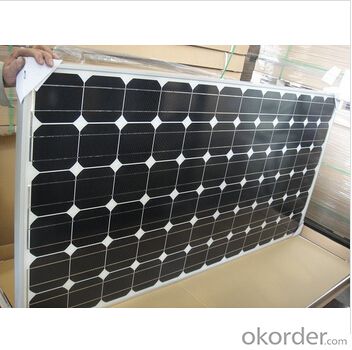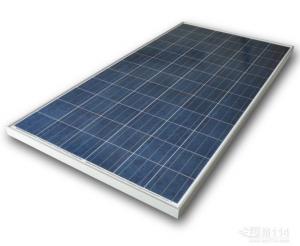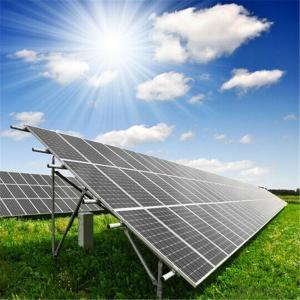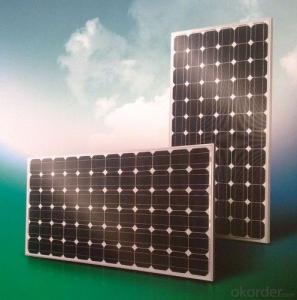Green Energy Solar Panels - Monocrystalline 315W Solar Module
- Loading Port:
- SHANGHAI
- Payment Terms:
- TT or LC
- Min Order Qty:
- -
- Supply Capability:
- 10000000 watt/month
OKorder Service Pledge
OKorder Financial Service
You Might Also Like
Description:
Solar modules use light energy (photons) from the sun to generate electricity through the photovoltaic effect.
The majority of modules use wafer-based crystalline silicon cells or thin-film cells based on cadmium telluride or silicon.
The structural (load carrying) member of a module can either be the top layer or the back layer.
Cells must also be protected from mechanical damage and moisture. Most solar modules are rigid, but semi-flexible ones are available,
based on thin-film cells. These early solar modules were first used in space in 1958.
CNBM Solar photovoltaic (PV) Panel is designed for large electrical power requirements.
It is the optimal choice for both on-grid and off-grid power systems.
CNBM Solar panel offers high performance of power per square foot of solar array.
Monocrystalline silicon(c-Si): often made using the Czochralski process. Single-crystal wafer cells tend to be expensive,
and because they are cut from cylindrical ingots, do not completely cover a square solar cell module without a substantial waste of refined silicon.
Hence most c-Si panels have uncovered gaps at the four corners of the cells.
Characteristics of Solar Monocrystalline
I. Solar Cell : High efficiency crystalline solar cell.
Even if under the weak light, the solar module can produce maximum power output.
II. Tempered glass (toughened glass): Anti-reflecting coating and high transmission rate glass increase
the power output and mechanical strength of solar module.
III. EVA and TPT: Using high quality EVA and TPT to prevent destroying and water.
IV. AI frame: Without screw, corner connection. 6 holes on the frame can be installed easily.
V. Junction box: Multi function junction box with water proof.
VI. Long lifetime: ≥25 years; Less power decrease.
VII. Good performance of preventing from atrocious weather such as wind and hails.
VIII. Resisting moisture and etching effectively, not effected by geology.
IX. The certificate issued by international authority: UL, TUV, IEC, VDE, CE.
Standard Test Conditions of Solar Monocrystalline
The opto-electrical specifications shown below are stabilized values being measured at Standard Test Conditions,
Irradiance: 1000W/m2, Spectrum: AM1.5 at 25°C, The info below is subject to manufacturing tolerances.
Where appropriate minutes of measurement are available and are used for the dimensioning of the installation.
Maximum Power (Pmax) | W | 315 |
Power Tolerance | W | (0,+5) |
Maximum Power Voltage (Vmp) | V | 37.5 |
Maximum Power Current (Imp) | A | 8.4 |
Open Circuit Voltage (Voc) | V | 46.30 |
Short Circuit Current (Isc) | A | 8.95 |
Module Efficiency (ηm) | % | 16.23 |
Dimension of module | mm | 1956*992*40mm(77.0*39.1*1.6inch) |
Pmax Temperature Coefficient | %/C | -0.44 |
Voc Temperature Coefficient | %/C | -0.32 |
Isc Temperature Coefficient | %/C | 0.44 |
Maximum System Voltage | VDC | 1000(TUV);600(UL) |
Maximum Series Fuse Rating | A | 15 |
Operating Temperature | C | -40~ +85 |
NOCT | C | 45±2 |
STC:1000W/m2.AM1.5 and 25C cell temperature, NOCT : Nominal Operating Cell Temperature | ||

FAQ:
1. How long will my inquiry get response?
Your inquiry related to our products or prices will be replied within 24 hours.
2. Can I get professional service and suggestion?
Well-trained and experienced staffs to answer all your questions in fluent English.
3. Do you accept OEM or customized design?
OEM & ODM, any your customized lightings we can help you to design and put into product.
4. What if I need specific design?
Distributorship are offered for your unique design and some our current models.
- Q: I thinking of buying a few solar panels, can anyone who had bought solar panels or sells them give me a price for them. I dot wanna over spend on them...
- Solar okorder or another site to compare prices.
- Q: For my Product Design Coursework I am designing an environment friendly building according to a clients' specifications. I need to find out the dimensions of 0000 watt solar panels. any help would be much appreciated!
- do those even exst that sounds prertty intesnse andn i see amny things that wou;ld go wrong with that i think you should like tone it done a bit that sounds pretty intense tho
- Q: Why can not the solar panel load directly?
- Solar panels (also known as solar modules) are the core of solar power systems and the most important part of solar power systems.
- Q: Can solar panels be installed on historic homes or buildings?
- Yes, solar panels can be installed on historic homes or buildings. However, it is important to consider the specific regulations and guidelines set by local historic preservation boards or authorities. In many cases, there are alternative installation methods available that minimize any visual impact on the historic aesthetics of the building. It is advisable to consult with experts in historic preservation and solar installation to ensure compliance with any necessary requirements.
- Q: I have a solar panel, charge regulator, inverter....is that all I need to tie it into my grid? Do I just plug the solar panel into the charge regulator into the inverter into any 0v outlet? I feel like im missing something....
- No don't do that unless you want a fire or worse electricution . DO NOT PLUG INTO THE WALL . st solar panel 2nd regulator 3rd 2 volt battery 4th inverter . The inverter should have 0 volt terminals that look like the plug on the wall . You would plug your TV or light into that the inverter . You would need an electrition to hook into your home electrical system . They will hook up a device made to tie into the grid or your meter that will make it run backwards but it takes alot of solar panels too do that . Please do not plug into wall .
- Q: am having a 75 watts siemens solar panel and is giving me 2.89volts during bright light, i wanted to know can this be used to charge 00Am/hr battery?
- Many of the panels used on homes are designed to produce 2 volts DC. 0 of them wired in a series would produce 20 volts DC. An inverter is used to change the DC voltage to AC. The other aspect of electricity is amperage. With electrical units wired in series the voltage is added. When they are wired in parallel the amperage is added. The Volts x Amps produced will give you the wattage. A wise homeowner will examine their electric bills or the equipment used to determine their demand. They will consult tables that let them know how much sunlight their area receives each year as this will alter the rated performance of the panels. Then they will try and determine how much of the demand they want to fill. 80% may be economical. Then they also want to determine what they will do with excess electricity that may be produced during the summer months of intense sun and how they will supply the shortfall of low sun winter months. From all this they will determine the number of solar panels they need to purchase.
- Q: i need technical and non technical details to generate MW power by solar panels
- Sorry if I don't have all the specifics you asked for, but Sun Power makes the most efficient solar panels on the market, at close to 20% efficiency. They have made cells with up to 25% efficiency in the lab. That doesn't make it the cheapest but means the most watts per square foot. Thin film panels are cheaper to make but not as efficient. They are about half as efficient as conventional silicon panels. First Solar makes the cheapest per watt right now. So I guess that makes them the actuall cheapest manufacturer. They are able to make them cheap enough to beat out the conventional silicon panels on a per watt basis, despite being less efficient. A company called NanoSolar has the price down close to First Solar's price. These are manufacturers. But they do installations and build utility and commercial scale projects. NanoSolar is less far along in commercialization. They have products, but probably need to wait for the stock market to be more favorable for IPOs, so they can go public and raise the money to move up to scale. The other two are already public.
- Q: If this was sold back to the grids what would be the profit i would stand to make per day on energy received in these panels? How did you come up with this answer?
- Considering capital outlays, such a system might never recover its initial investment. That's why we don't see such small photovoltaic plants popping up around the country - the economic case isn't there. One of the problems is that you would have to sell your electricity wholesale, at a ridiculously low price like 2 cents / kWh. If you were displacing electricity that you would otherwise use, then the financial case is different. Retail electricity could be 20 cents / kWh, 0 times as much, and you could get your money back over time, and start to make a profit. I've assumed you're in the US, with no special feed-in tarrifs. If you're in a country with a premium rate for solar-generated electricity, the business case could be very different.
- Q: Can solar panels be installed on a military base?
- Yes, solar panels can be installed on a military base. In fact, many military bases around the world have already implemented solar energy systems as part of their efforts to reduce dependence on fossil fuels and increase sustainability. Solar panels can be installed on rooftops, parking lots, or open grounds of military bases to generate clean renewable energy.
- Q: Can solar panels be installed on flat roofs?
- Yes, solar panels can be installed on flat roofs. In fact, flat roofs are often considered ideal for solar panel installations due to their easy accessibility and the ability to optimize panel positioning. However, it is important to conduct a structural analysis and ensure proper waterproofing measures are taken during the installation process.
Send your message to us
Green Energy Solar Panels - Monocrystalline 315W Solar Module
- Loading Port:
- SHANGHAI
- Payment Terms:
- TT or LC
- Min Order Qty:
- -
- Supply Capability:
- 10000000 watt/month
OKorder Service Pledge
OKorder Financial Service
Similar products
Hot products
Hot Searches
Related keywords


























